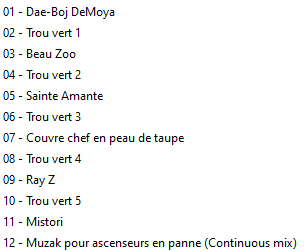Torrent details for "[ambient, electronic] (2020) Brigitte Barbu - Muzak pour ascenseurs en panne [FLAC] [DarkAngie]" Log in to bookmark
Name:
Controls:
Language:
 English
EnglishTotal Size:
398.30 MB
Info Hash:
56b6d72e29b502c248ddf252529315f6f34be0ea
Added By:
Added:
16-06-2020 16:04
Views:
473
Health:

Seeds:
0
Leechers:
0
Completed:
62
Review:
Brigitte Barbu, better known as French deep-house enigma Pépé Bradock, is an impossible man to pin down. After a brief scuffle with the mainstream at the end of the 1990s thanks to “Deep Burnt,” a jazzy house classic of immaculate poise, Bradock has retreated — or perhaps advanced — into a career of inscrutable oddity. His erratic release schedule wanders between moments of beauty, fear, and utter outlandishness. Muzak pour ascenseurs en panne (Muzak for Broken Elevators), only Bradock’s third album in 24 years — following the 1998 singles anthology Synthèse and last year’s appropriately titled collage effort What a Mess! — continues this beguiling and sometimes frustrating trend. The album is neither the “abstract hip-hop LP” that Bradock promised, nor an example of the deep house with which he made his name. There are no beats, for a start, and barely a hint of the constructive patterns that house typically demands; the songs instead ooze from one point to another like microorganisms in the primordial soup. Most eye-opening of all is the role that the electric guitar plays: Muzak pour ascenseurs en panne was recorded and mixed during a one-week studio residency with the guitar employed, he says, as “a brainwashed instrument, mirroring machines and computers.” The instrument’s presence shouldn’t be a total surprise—Bradock started playing guitar at 14, graduating to Parisian jazz-funk bands before house took over—but the instrument has barely featured in his music since. On the evidence of the exquisite, often entrancing, patches of guitar melody on Muzak, I wish it had. Bradock has a gift for the kind of atmospheric guitar traces that Steve Hillage employed on albums like Rainbow Dome Musick, notes misted onto the mix like the suggestion of rain. Rather than mirroring the machines, though, the guitar flows into them, dissolving the border between digital and analog as it joins Bradock’s collection of esoteric drones, trills, and pulses. The album’s best moments coincide with the strongest melodic work. “Dae Boj DeMoya” washes in on a gorgeously tender melody whose hybrid guitar/synth tone falls somewhere between a whistle, pedal steel, and slide guitar; its haunting tint of Americana evokes the KLF’s journey into the American dreamland on Chill Out, with the melody becoming progressively more enveloped in electronic curlicues as the track develops. “Sainte Amante” travels from spidery guitar lines to airy chords, which bathe the song’s electronic arpeggios in shimmering light, while “Mistori” uses a sublime combination of reverbed guitar and synth drone to trace layers of melody, ending up like Apollo: Atmospheres and Soundtracks if Brian Eno had set his controls for the heart of the sun rather than the moon’s barren surface. Muzak’s tendency to meander is both its charm and its Achilles’ heel. When the musical ideas are strong it is a luxury to drift along on Muzak’s wave, free from the distraction of beats or extraneous elements; when they are weak or ill defined, as on “Ray Z,” a track most notable for sporting a comically duck-like squelch, the music feels rather slight, more a collection of sounds than anything approaching a song. On an album this short—with just six songs and five brief sketches to its name—this feels wasteful. Perhaps completing an album in one week was an unrealistic proposition for an artist who confesses to work at the pace of a “Burgundy snail.” Then again, the tendency for dazzling self-sabotage is typically Pépé Bradock, a hugely talented producer whose obduracy is part of the package. There are no simple answers to the Bradock riddle, and nor would you want them. This week he’s Brigitte Barbu, recording amorphic, guitar-led caprice; the next week he won’t be, but Muzak pour ascenseurs en panne remains another perfectly imperfect milestone along Bradock’s exasperating golden path.

Tracklist:

Media Report:
Genre: ambient, electronic
Source: CD
Format: FLAC
Format/Info: Free Lossless Audio Codec, 16-bit PCM
Bit rate mode: Variable
Channel(s): 2 channels
Sampling rate: 44.1 KHz
Bit depth: 16 bits










































